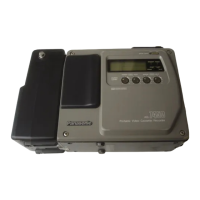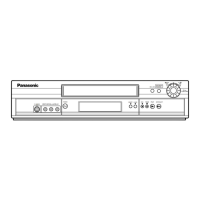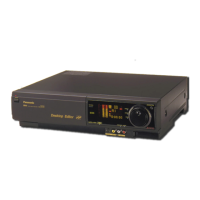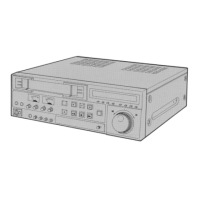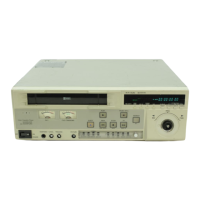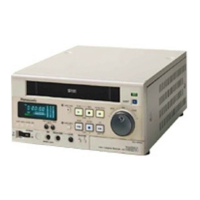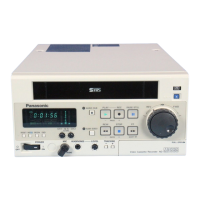Do you have a question about the Panasonic AG-5700-P and is the answer not in the manual?
Checks for damage and lists included accessories like the S-VIDEO Cable.
Lists available optional accessories such as the remote controller and video cassette tape.
Supports 2/6 hour recording/playback on VHS/S-VHS tapes, including Hi-Fi audio.
Features normal, double-speed, slow-motion, repeat, and VISS search playback.
Includes sensor recording, audio dubbing, video insert, and computer control.
Illuminated buttons, auto power ON/OFF, and remote operation capabilities.
Buttons for memory functions, tape searching, and resetting operations.
Adjusts Hi-Fi audio levels and selects audio output for monitoring.
Buttons for playback, recording, pause, tape ejection, and power.
Displays tape counter, allows tracking adjustment, and provides mic/headphone connections.
Provides BNC and PHONO connectors for various video and audio signals.
Switches for S-VHS/VHS modes, video input selection, and RS-232C remote control.
Switches for enabling automatic tape repeat playback and sensor recording.
Locks front panel controls to prevent accidental changes during operation.
Steps before recording, including tape loading and selector settings.
Adjusts Hi-Fi audio input levels for optimal recording quality.
Procedure for starting, pausing, and stopping recording.
Steps before playback and initiating normal playback with tracking adjustment.
Warnings regarding interference and features like double-speed and slow-motion playback.
Functionality of the mode lock switch to disable front panel controls.
Instructions for fast winding, rewinding, and locating specific scenes.
Freezing the picture at a specific frame and stopping playback.
Using the button for memory stop and search displays.
Stopping the tape near '0000' and performing forward/reverse search playback.
Resetting the tape counter to '00000'.
Searching for VISS signals during FF operation.
Setting up for continuous playback from tape beginning to end.
Setting up for playback from beginning to video signal interruption.
System for searching recorded scenes using index signals.
Automatic recording triggered by an incoming video signal.
Steps before performing audio dubbing, including tape tab check.
Procedure for recording new audio over existing audio tracks.
Using the optional AG-A11 remote controller for operation.
Controlling the unit via computer using RS-232C cable.
List of basic VTR functions controllable via RS-232C.
Detailed interface specifications for RS-232C connection.
Performing editing and searching operations via RS-232C.
Configuring baud rate, protocol, data bits, and stop bits.
Details on communication format, speed, and data bits.
Structure and rules for sending commands to the VTR.
Format of data and error responses received from the VTR.
Commands for basic VTR control like stopping, ejecting, and playing.
Commands for fast forwarding, pausing, recording, and still frame.
Commands for frame advancement and reverse playback.
Commands for controlling forward and reverse shuttle speeds.
Commands to set slow mode and adjust playback speed.
Commands for preparing insert and audio dubbing operations.
Commands to specify video, audio, or A/V insert positions.
Command to perform audio and video insert operations.
Commands to set coarse and fine search modes.
Commands for searching and playing or pausing at a specific counter position.
Command to play to a specified position and then pause.
Commands for adjusting shuttle playback speed.
Commands to turn the VTR power ON or OFF.
Command to inquire about the VTR's current operating mode.
Command to query the VTR's internal processing state via a bit map.
Understanding the meaning of VTR status bits.
Guidelines for sending commands to avoid processing errors.
Command to inquire the current value of the tape counter.
Commands for resetting and calibrating the tape counter.
Commands for checking communication, ROM version, and deck ID.
Handling errors from missing spaces or incorrect data ranges in commands.
Understanding command acceptance limits during VTR operations.
Specifies the minimum time interval between RS-232C commands.
Lists commands that need time for system control microprocessor processing.
Summary of send commands for basic VTR operations and their responses.
Tables for search, mode, and data sense commands.
Summary of commands for counter reset, calibration, and version checks.
Illustrates how VTR modes change based on RS-232C commands.
Explains how to read the VTR mode transition table and command responses.
Advisories on unit operation, avoiding hazards, and basic maintenance.
Guidance on cleaning heads and handling dew indication.
Steps to resolve issues related to power and button operations.
Solutions for tape ejection, noisy pictures, and wavy playback.
Details on power, TV system, tape type, speed, and recording times.
Specs for video/audio inputs/outputs, resolution, and operating conditions.
Checks for damage and lists included accessories like the S-VIDEO Cable.
Lists available optional accessories such as the remote controller and video cassette tape.
Supports 2/6 hour recording/playback on VHS/S-VHS tapes, including Hi-Fi audio.
Features normal, double-speed, slow-motion, repeat, and VISS search playback.
Includes sensor recording, audio dubbing, video insert, and computer control.
Illuminated buttons, auto power ON/OFF, and remote operation capabilities.
Buttons for memory functions, tape searching, and resetting operations.
Adjusts Hi-Fi audio levels and selects audio output for monitoring.
Buttons for playback, recording, pause, tape ejection, and power.
Displays tape counter, allows tracking adjustment, and provides mic/headphone connections.
Provides BNC and PHONO connectors for various video and audio signals.
Switches for S-VHS/VHS modes, video input selection, and RS-232C remote control.
Switches for enabling automatic tape repeat playback and sensor recording.
Locks front panel controls to prevent accidental changes during operation.
Steps before recording, including tape loading and selector settings.
Adjusts Hi-Fi audio input levels for optimal recording quality.
Procedure for starting, pausing, and stopping recording.
Steps before playback and initiating normal playback with tracking adjustment.
Warnings regarding interference and features like double-speed and slow-motion playback.
Functionality of the mode lock switch to disable front panel controls.
Instructions for fast winding, rewinding, and locating specific scenes.
Freezing the picture at a specific frame and stopping playback.
Using the button for memory stop and search displays.
Stopping the tape near '0000' and performing forward/reverse search playback.
Resetting the tape counter to '00000'.
Searching for VISS signals during FF operation.
Setting up for continuous playback from tape beginning to end.
Setting up for playback from beginning to video signal interruption.
System for searching recorded scenes using index signals.
Automatic recording triggered by an incoming video signal.
Steps before performing audio dubbing, including tape tab check.
Procedure for recording new audio over existing audio tracks.
Using the optional AG-A11 remote controller for operation.
Controlling the unit via computer using RS-232C cable.
List of basic VTR functions controllable via RS-232C.
Detailed interface specifications for RS-232C connection.
Performing editing and searching operations via RS-232C.
Configuring baud rate, protocol, data bits, and stop bits.
Details on communication format, speed, and data bits.
Structure and rules for sending commands to the VTR.
Format of data and error responses received from the VTR.
Commands for basic VTR control like stopping, ejecting, and playing.
Commands for fast forwarding, pausing, recording, and still frame.
Commands for frame advancement and reverse playback.
Commands for controlling forward and reverse shuttle speeds.
Commands to set slow mode and adjust playback speed.
Commands for preparing insert and audio dubbing operations.
Commands to specify video, audio, or A/V insert positions.
Command to perform audio and video insert operations.
Commands to set coarse and fine search modes.
Commands for searching and playing or pausing at a specific counter position.
Command to play to a specified position and then pause.
Commands for adjusting shuttle playback speed.
Commands to turn the VTR power ON or OFF.
Command to inquire about the VTR's current operating mode.
Command to query the VTR's internal processing state via a bit map.
Understanding the meaning of VTR status bits.
Guidelines for sending commands to avoid processing errors.
Command to inquire the current value of the tape counter.
Commands for resetting and calibrating the tape counter.
Commands for checking communication, ROM version, and deck ID.
Handling errors from missing spaces or incorrect data ranges in commands.
Understanding command acceptance limits during VTR operations.
Specifies the minimum time interval between RS-232C commands.
Lists commands that need time for system control microprocessor processing.
Summary of send commands for basic VTR operations and their responses.
Tables for search, mode, and data sense commands.
Summary of commands for counter reset, calibration, and version checks.
Illustrates how VTR modes change based on RS-232C commands.
Explains how to read the VTR mode transition table and command responses.
Advisories on unit operation, avoiding hazards, and basic maintenance.
Guidance on cleaning heads and handling dew indication.
Steps to resolve issues related to power and button operations.
Solutions for tape ejection, noisy pictures, and wavy playback.
Details on power, TV system, tape type, speed, and recording times.
Specs for video/audio inputs/outputs, resolution, and operating conditions.
| Recording Speed | SP, LP, EP |
|---|---|
| Audio System | Hi-Fi Stereo |
| Remote Control | Yes |
| Timer | Yes |
| Video Format | VHS |

